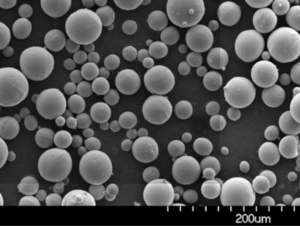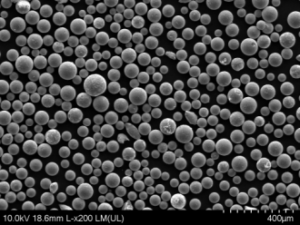Poudre d'alliage durcissant par frittage est un héros méconnu dans le monde de la science des matériaux. Cette merveille d'ingénierie combine les avantages du frittage - une méthode utilisée pour créer des structures solides à partir de poudres - avec les avantages supplémentaires des processus de durcissement. Ce mélange unique crée un matériau qui est non seulement solide et durable, mais aussi plus facile à produire et plus rentable que les méthodes traditionnelles. Que vous soyez un spécialiste des matériaux, un ingénieur ou un simple lecteur curieux, ce guide vous plongera dans les subtilités des poudres d'alliage durcissant par frittage, en vous offrant une vue d'ensemble de ce qui rend ces matériaux si spéciaux.
Aperçu de la poudre d'alliage durcissant par frittage
Les poudres d'alliage durcissant par frittage sont des poudres métalliques spécialisées conçues pour durcir pendant le processus de frittage lui-même. Cette double fonctionnalité élimine la nécessité d'un traitement thermique supplémentaire, ce qui réduit les délais et les coûts de production tout en produisant des pièces très solides et résistantes à l'usure. Ces poudres sont principalement utilisées dans la fabrication de pièces de haute performance dans les secteurs de l'automobile, de l'aérospatiale et de l'outillage.
Faits marquants :
- Applications polyvalentes: Des engrenages automobiles aux composants aérospatiaux, les poudres d'alliage durcissant par frittage sont utilisées dans diverses industries.
- Une production rentable: Le procédé de frittage-durcissement combine le frittage et le durcissement, ce qui réduit la nécessité d'étapes de traitement supplémentaires.
- Caractéristiques de haute performance: Ces poudres offrent des propriétés mécaniques exceptionnelles, notamment la solidité, la ténacité et la résistance à l'usure.

Composition de la poudre d'alliage durcissant par frittage
La composition des poudres d'alliage durcissant par frittage est déterminante pour leurs performances. Ces poudres sont généralement composées d'un métal de base, tel que le fer, mélangé à des éléments d'alliage qui favorisent le durcissement au cours du processus de frittage. La sélection de ces éléments et leurs concentrations sont soigneusement équilibrées pour obtenir les propriétés mécaniques souhaitées.
| Modèle de poudre métallique | Composition | Éléments d'alliage primaire | Caractéristiques notables |
|---|---|---|---|
| SH-42 | A base de fer | Nickel, molybdène | Ténacité élevée, résistance à l'usure |
| SH-55 | A base de cuivre | Nickel, chrome | Excellente résistance à la corrosion |
| SH-62 | A base de fer | Carbone, Manganèse | Dureté et résistance améliorées |
| SH-78 | acier inoxydable | Chrome, Nickel | Résistance élevée à la corrosion, bonne dureté |
| SH-81 | A base de fer | Chrome, molybdène | Résistance à l'usure et dureté supérieures |
| SH-94 | A base de nickel | Molybdène, bore | Haute résistance à des températures élevées |
| SH-100 | A base de titane | Aluminium, Vanadium | Léger, excellent rapport résistance/poids |
| SH-120 | A base de fer | Silicium, Manganèse | Ténacité et usinabilité accrues |
| SH-130 | A base de cuivre | Etain, Zinc | Bonne conductivité, résistance moyenne |
| SH-145 | A base de fer | Carbone, Silicium | Dureté accrue, fragilité réduite |
Chacune de ces poudres est conçue pour répondre à des exigences spécifiques, qu'il s'agisse d'une résistance élevée à l'usure, d'une meilleure ténacité ou d'une résistance supérieure à la corrosion.
Caractéristiques des Poudre d'alliage durcissant par frittage
Les caractéristiques des poudres d'alliage durcissant par frittage sont ce qui les rend si précieuses dans les applications industrielles. Ces poudres combinent les avantages du frittage et de la trempe en un seul processus, ce qui permet d'obtenir des matériaux exceptionnellement solides et résistants à l'usure.
Propriétés mécaniques :
- La force: Les poudres de durcissement par frittage produisent des composants présentant une résistance élevée à la traction et à la compression, ce qui les rend aptes à supporter des charges.
- Solidité: Ces poudres offrent une excellente ténacité, permettant au matériau d'absorber l'énergie et de résister aux fractures.
- Résistance à l'usure: Les éléments de durcissement contenus dans ces poudres contribuent à une résistance supérieure à l'usure, prolongeant ainsi la durée de vie des composants.
Propriétés physiques :
- Densité: Les poudres durcies par frittage atteignent généralement une densité élevée, ce qui contribue à leur résistance mécanique.
- Porosité: Le processus de frittage peut être contrôlé pour réduire la porosité, ce qui permet d'obtenir des matériaux ayant une structure plus uniforme et de meilleures propriétés mécaniques.
Propriétés thermiques :
- Résistance à la chaleur: Certaines poudres durcissant par frittage, en particulier celles à base de nickel ou de titane, présentent une excellente résistance à la chaleur et conservent leurs propriétés mécaniques à des températures élevées.
- Conductivité thermique: En fonction du métal de base, ces poudres peuvent offrir une bonne conductivité thermique, ce qui est bénéfique pour les applications nécessitant une dissipation de la chaleur.
Avantages de la poudre d'alliage durcissant par frittage
Les poudres d'alliage durcissant par frittage offrent une série d'avantages qui en font un matériau de choix pour diverses applications à hautes performances.
Le rapport coût-efficacité :
- Réduction des étapes de traitement: La combinaison du frittage et de la trempe en une seule étape réduit la nécessité de traitements thermiques supplémentaires, ce qui permet d'économiser du temps et de l'argent.
- Réduction de la consommation d'énergie: Le processus intégré de frittage-durcissement consomme moins d'énergie que les méthodes traditionnelles qui nécessitent des étapes de frittage et de durcissement séparées.
Amélioration des performances :
- Propriétés mécaniques améliorées: Les composants fabriqués à partir de poudres durcissant par frittage présentent une solidité, une ténacité et une résistance à l'usure supérieures à celles des composants fabriqués à partir de matériaux frittés traditionnels.
- Une qualité constante: La composition contrôlée et la distribution uniforme des éléments d'alliage garantissent une qualité et des performances constantes dans les différents lots.
Polyvalence :
- Large éventail d'applications: Des pièces automobiles aux composants aérospatiaux, les poudres durcissant par frittage peuvent être utilisées dans une grande variété d'applications, ce qui les rend très polyvalentes.
- Personnalisation: Ces poudres peuvent être adaptées pour répondre à des exigences spécifiques en ajustant la composition et les paramètres de traitement.

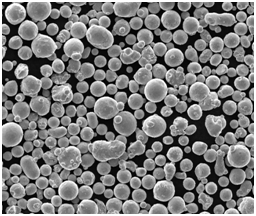
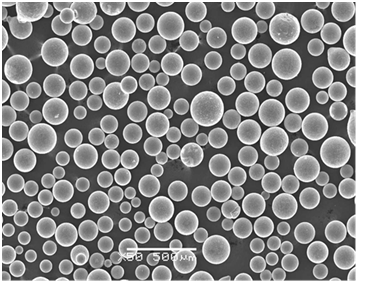
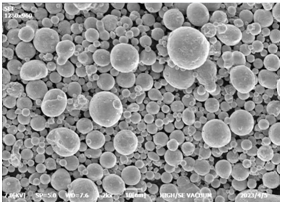


Applications de la poudre d'alliage durcissant par frittage
Les poudres d'alliage durcissant par frittage sont utilisées dans une large gamme d'applications en raison de leurs propriétés mécaniques exceptionnelles et de leur rentabilité.
| L'industrie | Applications courantes | Avantages |
|---|---|---|
| Automobile | Engrenages, composants de transmission, pièces de moteur | Haute résistance, résistance à l'usure, production rentable |
| Aérospatiale | Aubes de turbines, composants structurels | Légèreté, résistance aux hautes températures |
| Outillage | Outils de coupe, matrices, moules | Dureté supérieure, durée de vie prolongée |
| Électronique | Dissipateurs thermiques, connecteurs | Bonne conductivité thermique, résistance à la corrosion |
| Médical | Implants, instruments chirurgicaux | Biocompatibilité, solidité, résistance à la corrosion |
| Pétrole et gaz | Trépans, valves, joints | Résistance élevée à l'usure et à la corrosion |
| Biens de consommation | Montres, bijoux, appareils électroménagers haut de gamme | Esthétique, durabilité |
| Machines industrielles | Roulements, engrenages, fixations | Capacité de charge élevée, résistance à l'usure |
| Défense | Armures, composants d'armes | Haute résistance, résistance aux chocs |
| L'énergie | Piles à combustible, composants de batteries | Haute efficacité, long cycle de vie |
Ces applications mettent en évidence la polyvalence et les performances des poudres d'alliage durcissant par frittage dans différentes industries.
Spécifications, tailles, qualités et normes
Lors de la sélection des poudres d'alliage durcissant par frittage, il est important de prendre en compte les spécifications, les tailles, les qualités et les normes qui s'appliquent à votre application spécifique.
| Modèle de poudre métallique | Gamme de taille des particules (μm) | Grade | Conformité aux normes |
|---|---|---|---|
| SH-42 | 10-50 | A2 | ASTM B783, MPIF 35 |
| SH-55 | 15-45 | B3 | ISO 5755, DIN 3572 |
| SH-62 | 20-60 | A1 | ASTM B783, ISO 4499 |
| SH-78 | 5-30 | C1 | ASTM B243, MPIF 35 |
| SH-81 | 25-70 | B1 | ISO 4499, DIN 30910 |
| SH-94 | 15-45 | A3 | ASTM B312, MPIF 35 |
| SH-100 | 10-40 | C2 | ISO 5755, ASTM B312 |
| SH-120 | 10-50 | A2 | MPIF 35, DIN 30910 |
| SH-130 | 20-60 | B2 | ISO 5755, ASTM B243 |
| SH-145 | 15-55 | C1 | ASTM B243, ISO 5755 |
Le choix de la bonne qualité et de la bonne norme est crucial pour s'assurer que le matériau répond aux critères de performance nécessaires pour votre application.
Fournisseurs et détails des prix
Comprendre le marché des poudres d'alliage durcissant par frittage peut vous aider à prendre des décisions d'achat éclairées. Vous trouverez ci-dessous quelques-uns des principaux fournisseurs et des informations générales sur les prix de ces poudres.
| Fournisseur | Localisation | Modèle de poudre métallique | Fourchette de prix (par kg) | Délai de livraison |
|---|---|---|---|---|
| Poudres métalliques avancées | États-Unis | SH-42, SH-55 | $20 – $50 | 2-4 semaines |
| Global Powders Ltd. | Royaume-Uni | SH-62, SH-78 | $25 – $60 | 3-6 semaines |
| Solutions métallurgiques | Allemagne | SH-81, SH-94 | $30 – $70 | 4-8 semaines |
| PowderTech | Chine | SH-100, SH-120 | $15 – $40 | 3-5 semaines |
| Alliages de l'Est | Japon | SH-130, SH-145 | $35 – $75 | 2-5 semaines |
Les prix peuvent varier en fonction du fournisseur, de la quantité commandée et des exigences spécifiques de votre application.
Avantages et inconvénients de la poudre d'alliage durcissant par frittage
Si les poudres d'alliage durcissant par frittage offrent de nombreux avantages, elles présentent également certaines limites. Comprendre celles-ci peut vous aider à prendre la meilleure décision pour vos besoins spécifiques.
| Aspect | Avantages | Limites |
|---|---|---|
| Processus de production | Combine le frittage et le durcissement, réduisant ainsi les étapes de production | Nécessite un contrôle précis des conditions de frittage |
| Coût | Coût global inférieur grâce à la réduction des étapes de traitement | L'investissement initial dans l'équipement de frittage peut être élevé |
| Propriétés mécaniques | Grande solidité, résistance à l'usure et ténacité | Limité à des compositions d'alliage spécifiques |
| Polyvalence | Convient à une large gamme d'applications | Peut ne pas convenir à toutes les applications à haute température |
| Personnalisation | Peut être adapté à des besoins spécifiques | Les poudres personnalisées peuvent être plus chères que les poudres standard |
| Efficacité énergétique | Consommation d'énergie réduite grâce au processus combiné | Peut ne pas atteindre les mêmes propriétés que les matériaux durcis séparément |
Ces avantages et inconvénients illustrent les compromis liés à l'utilisation de poudres d'alliage durcissant par frittage, ce qui vous aidera à prendre une décision éclairée en fonction de vos besoins spécifiques.
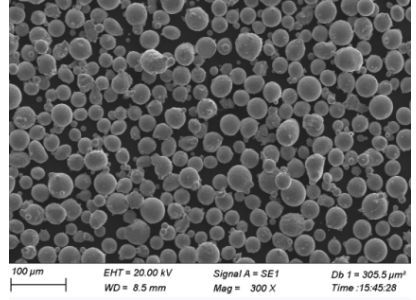
FAQ
Pour conclure, voici quelques questions fréquemment posées sur les poudres d'alliage durcissant par frittage, présentées sous forme de tableau pour une consultation rapide.
| Question | Réponse |
|---|---|
| Qu'est-ce que la poudre d'alliage durcissant par frittage ? | La poudre d'alliage durcissant par frittage est une poudre métallique conçue pour subir un durcissement au cours du processus de frittage, ce qui élimine la nécessité d'un traitement thermique supplémentaire. |
| Quels sont les principaux avantages de l'utilisation de poudres durcissant par frittage ? | Ils offrent une production rentable, une grande solidité, une résistance à l'usure et peuvent être adaptés à des applications spécifiques. |
| Dans quelles industries les poudres durcissant par frittage sont-elles couramment utilisées ? | Industries automobile, aérospatiale, de l'outillage, de l'électronique, médicale, pétrolière et gazière, et des biens de consommation. |
| En quoi le durcissement par frittage diffère-t-il du frittage traditionnel ? | La trempe par frittage combine le frittage et le durcissement en une seule étape, ce qui permet de réduire le temps de production et d'améliorer les propriétés des matériaux. |
| Les poudres durcissant par frittage peuvent-elles être personnalisées ? | Oui, ils peuvent être adaptés en ajustant la composition et les paramètres de traitement pour répondre aux exigences d'une application spécifique. |
| Quelles sont les limites des poudres d'alliage durcissant par frittage ? | Ils peuvent nécessiter un contrôle précis des conditions de frittage et ne pas convenir à toutes les applications à haute température. |
| Quel est le coût des poudres durcissant par frittage par rapport aux poudres traditionnelles ? | Les poudres durcissant par frittage peuvent être plus rentables en raison de la réduction des étapes de traitement, mais l'investissement initial dans l'équipement peut être élevé. |
| Les poudres durcissant par frittage sont-elles respectueuses de l'environnement ? | Ils peuvent être plus efficaces sur le plan énergétique grâce au processus combiné, ce qui réduit l'impact global de la production sur l'environnement. |
| Quels sont les modèles de poudres métalliques les plus courants ? | On peut citer les exemples suivants : SH-42, SH-55, SH-62, SH-78, SH-81, SH-94, SH-100, SH-120, SH-130 et SH-145. |
| Où puis-je acheter des poudres d'alliage durcissant par frittage ? | Les poudres durcissant par frittage peuvent être achetées auprès de fournisseurs tels que Advanced Metal Powders, Global Powders Ltd. et PowderTech. |
Conclusion
Poudres d'alliage durcissant par frittage représentent une avancée significative dans la science des matériaux, offrant une combinaison unique de résistance, de durabilité et de rentabilité. Que vous développiez des composants automobiles de haute performance ou des pièces aérospatiales de pointe, ces poudres constituent une solution polyvalente et fiable. En comprenant la composition, les caractéristiques, les avantages et les applications des poudres d'alliage durcissant par frittage, vous pouvez prendre des décisions éclairées qui vous aideront à optimiser vos processus de production et à obtenir des résultats supérieurs.
